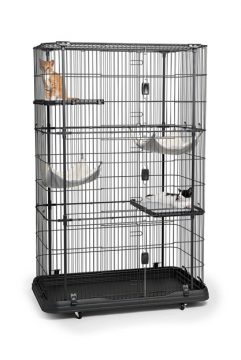

Before your welcome home your new kitten, a number of things have to be ready. The items I advise you to have installed in your home are:
- Basket or cushion in a quiet place
- Scratching pole (with washable cushions)
- Litter tray (somewhere where the kitten can find it easily and preferably open)
- Travel basket
- Food bowl for dry food
- Food bowl or plate for meat
- Water bowl
- Toys, including a cat rod
- Flea comb
- A brush (the best is a short pin pal, brush, a so-called ‘terrier pad’)
Make sure your home is safe. A kitten must be unable to hurt itself, swallow small items or bite in electrical wiring. Also remove poisonous plants.

Nutrition
The first few days, provide the same food the kitten was used to eat in our cattery. If you want to change to a new food, introduce it very slowly by mixing the new food with the old. Make sure there is Always food available for the kitten. Clean the drinking bowl daily.
Habitation
Initially make sure the kitten cannot hide in its available space (for example under a sofa). The kitten will approach it new owners more easily and will become less shy. A bathroom or a similar small room is suitable.
 In the first week, if the kitten starts meowing during the night in order to get attention, please go to him. It is a attempting idea to stay in your bed, but by getting up for the kitten only the first days, you will create a great bond. The experience with my own cats, is that because of this they have developed an extra strong bond with me and still have, now they are grown up. When I got downstairs half asleep, the small meowing kitten would jump in my arms and start purring immediately. I would stay with the kitten for about half an hour to pet it, reassure it and to tire it by playing. After returning to my bed, the kitten would meow for a further five minutes, but then stop and go to sleep. The kitten would wake up happily the next morning. Only once did I have to get up twice during the night. After the first week, the kitten would sleep through the night and also did not meow loudly anymore if I left my home for a short period during daylight hours.
In the first week, if the kitten starts meowing during the night in order to get attention, please go to him. It is a attempting idea to stay in your bed, but by getting up for the kitten only the first days, you will create a great bond. The experience with my own cats, is that because of this they have developed an extra strong bond with me and still have, now they are grown up. When I got downstairs half asleep, the small meowing kitten would jump in my arms and start purring immediately. I would stay with the kitten for about half an hour to pet it, reassure it and to tire it by playing. After returning to my bed, the kitten would meow for a further five minutes, but then stop and go to sleep. The kitten would wake up happily the next morning. Only once did I have to get up twice during the night. After the first week, the kitten would sleep through the night and also did not meow loudly anymore if I left my home for a short period during daylight hours.
Training
The best way to train your kitten is by rewarding positive behavior with a sweet voice and cuddles. If it scratches a forbidden object, pick the kitten up and take it to its scratching pole. Carefully move its paws across the scratching pole. It may sound a bit weird, but it also might help if you ‘scratch’ the scratching pole with your own nails when your kitten is watching.
When the kitten shows undesirable behavior such as hanging on the curtains, remove it and say clearly NO (but do not shout). If the behavior re-occurs, say NO again and give the kitten a time-out in, for example, its cage. After a few minutes, let the kitten out and provide some distraction. This could be by playing.
Quarantine when you already have cats in your home
If you already have a cat in your home, the new kitten has to go into quarantine for at least seven days, but fourteen days is even better. This means that the first seven days (s)he must not be in the same room with the existing cat or cats. The stress caused by the move and the removal away from its mother, lowers the kitten’s resistance. The existing cats may carry viruses which do not cause illness because of their normal resistance, but your new kitten may get infected by it. Keeping your new kitten in quarantine also gives you the opportunity to closely monitor its health. Furthermore, during the quarantine period the kitten will bond very well with its new owner(s).
the existing cat or cats. The stress caused by the move and the removal away from its mother, lowers the kitten’s resistance. The existing cats may carry viruses which do not cause illness because of their normal resistance, but your new kitten may get infected by it. Keeping your new kitten in quarantine also gives you the opportunity to closely monitor its health. Furthermore, during the quarantine period the kitten will bond very well with its new owner(s).

Introduction to other cats
When you want to introduce your new kitten to the other cats in your home, I advise the following:
- Make sure the other cats cannot touch the new kitten initially, but can get used to it through other senses. This may can happen visually (glass) or by scent by having the kitten in a neighboring room.
- Occasionally, and without the other cats being around, after the quarantine period you can let the new kitten explore the new surroundings.
- The next step – if possible – is a cage in the living room. The kitten will be safe in it from the other cats, but can communicate with them.
- If all goes well so far, the next move is to let the new kitten share the same space as the other cats for short periods of time. Make sure you stay with them to keep an eye on things. May there be unwanted interaction, you can separate the cats with cushions.
Every situation and every cat are different, but after a quarreling start, it usually takes 1-2 weeks before the cats get along. The introduction of an adult cat is usually is more difficult. I prefer to introduce kittens if possible.
